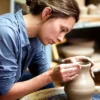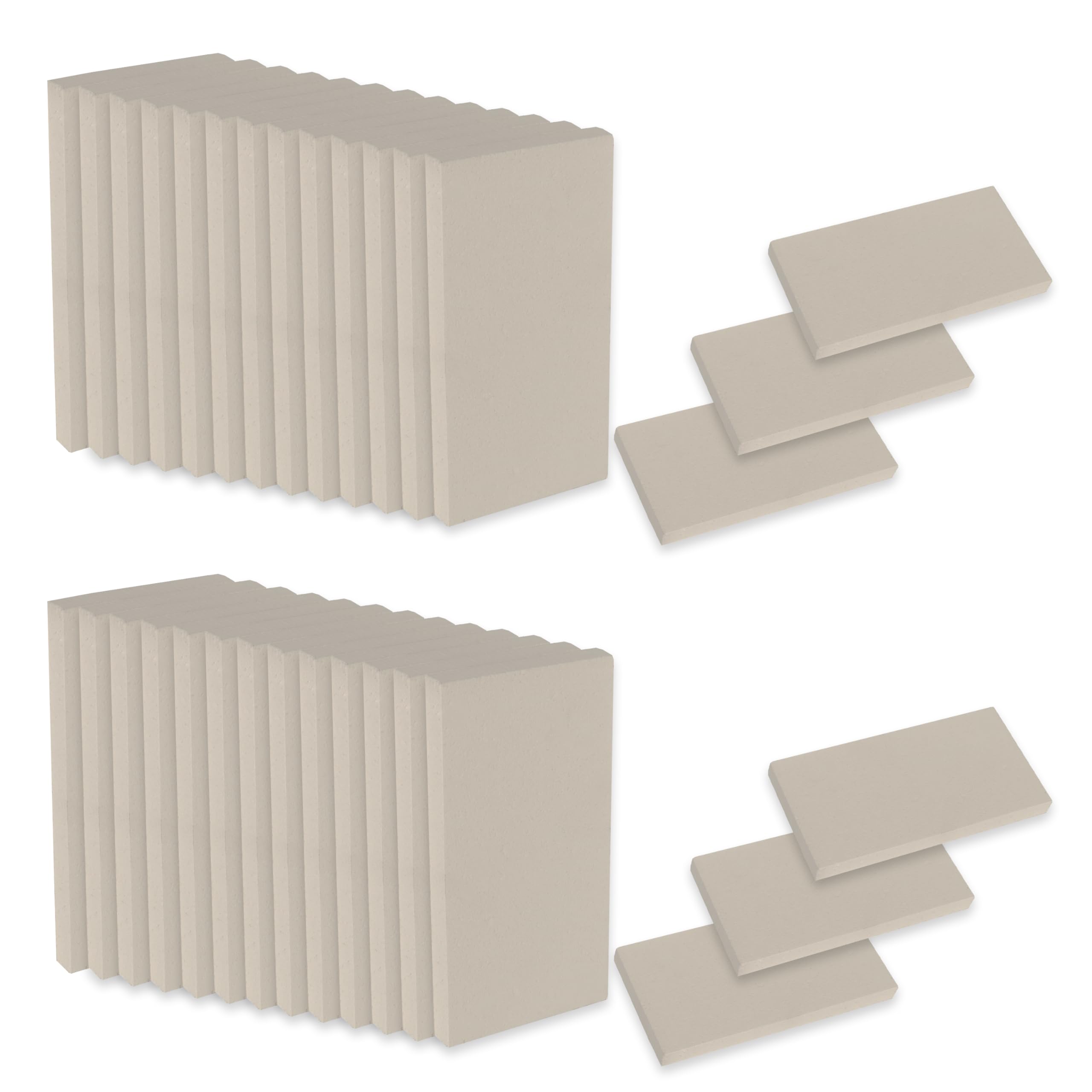In the world of pottery, refractory clay plays a crucial role in creating durable and heat-resistant ceramics.
This type of clay is specifically designed to withstand high temperatures, making it ideal for creating pieces intended for functional use, like cookware and tiles.
Unlike regular clay, refractory clay provides the strength and resilience needed to hold up in kiln environments, ensuring that the final products are both beautiful and practical.
When selecting refractory clay for pottery, there are several factors to consider.
The composition of the clay is essential, as it determines both its heat resistance and workability.
Some refractory clays might contain added materials like grog, which can affect texture and firing temperature.
Additionally, potters should consider how the clay’s properties align with their specific project needs, whether it’s making a sculpture or producing functional ware.
Finding the best refractory clay for pottery requires careful evaluation and testing.
We looked at various options to identify those that offer optimal performance in terms of durability, usability, and heat resistance.
Best Refractory Clay for Pottery
We’ve evaluated various options to bring you our selection of the best refractory clay for pottery projects.
Whether you’re focusing on durability or ease of shaping, our curated list will help guide you to the right choice for your creative needs.
ZENFUN Pottery Firing Mat
This reliable firing mat is a sturdy choice for potters looking to improve their ceramic creations with ease.
- Durable material withstands high temperatures
- Flexible nail arrangement for versatile use
- Reduces waste by preventing glaze issues
- Might require kiln wash to prevent sticking
- Smaller size limits larger projects
- Some reports of sticking with glaze
In our time spent with the ZENFUN Pottery Firing Mat, we found it a durable companion in the kiln.
The material holds up under high temperatures, allowing us to fire ceramics repeatedly without worry.
This mat has helped minimize waste by keeping glaze issues to a minimum.
Its durability is unparalleled and offers peace of mind for frequent firings.
The design allows flexibility in arranging the nails, accommodating a wide range of craft sizes.
We appreciated the thoughtful features that let us avoid complications like cracked ceramics or glaze sticking.
Although its compact size may not suit larger projects, it perfectly fits smaller items, making it versatile for various crafts.
While some users noted the need for coating with kiln wash, we found it mitigated sticking problems and improved results.
It’s a minor preparation for a tool that significantly enhances pottery firing.
Overall, this mat serves as an essential tool for those passionate about ceramics.
Tideme Pottery Firing Mats
This set is perfect for those seeking reliable support for high-temperature pottery projects.
- High resistance to extreme temperatures
- Includes a comprehensive set with support pins
- Space-efficient storage solution
- Limited to small kiln sizes
- Slightly higher cost compared to basic models
- Requires careful pin placement for stability
We found the Tideme Pottery Firing Mats to be a comprehensive and efficient solution for pottery enthusiasts.
The dual ceramic refractory pads and the 120 kiln stilt support nails are thoughtfully designed to cater to various pottery firing needs.
The high alumina refractory materials provide exceptional heat resistance, standing firm even in high-temperature conditions.
Whether you’re a hobbyist or a professional, these mats offer a reliable foundation for your ceramic creations.
The compact design of these refractory pads makes them easy to handle and store.
With dimensions of just 3.9 x 3.9 inches, they’re perfectly suited for smaller kilns.
The accompanying plastic storage box keeps everything neatly organized, making transportation and storage hassle-free.
This set is not only durable but also designed for convenience.
We did notice that careful attention is required for inserting and removing support pins to ensure stability during firing cycles.
The multi-hole design makes it relatively simple, yet the process demands a bit of precision.
Despite this, the benefits of using these firing mats outweigh the minor setup nuances.
These pottery pads are a solid investment for anyone serious about their ceramic projects.
CALPALMY Natural Clay for Pottery
This is a dependable choice for anyone looking to pursue pottery projects with high-quality natural air-dry clay.
- Excellent texture for easy sculpting
- Non-toxic and safe for all users
- Versatile for different project types
- Requires careful drying to prevent cracking
- Limited color options
- Slightly heavier, which may be less ideal for beginners
Working with the CALPALMY Natural Clay was a pleasure; its smooth and uniform texture made shaping and sculpting remarkably simple.
We felt confident using this clay knowing it was non-toxic, which is essential for both safety and ease of use.
Experimenting with this clay across various projects, from hand-building to pottery wheel creations, highlighted its versatility and adaptability.
It’s ideal not just for seasoned artists but also for hobbyists exploring their creative side, accommodating a wide range of applications from modeling to high-temperature firing.
Drying, though, needs a bit of attention.
It’s crucial to ensure the clay dries slowly to avoid cracking.
Storing our finished pieces in a cool, dark place helped maintain their durability and appearance, proving this clay to be a reliable companion in our creative adventures.
SIMOND STORE Fire Bricks
These fire bricks are an excellent choice for anyone needing durable and efficient refractory solutions.
- Robust structure with high compressive strength
- Efficient thermal insulation up to 2500F
- Lightweight and easy to handle
- Limited to specific dimensions
- May require dry storage conditions
- Initial investment could be higher
We’ve found the SIMOND STORE Fire Bricks to be quite impressive with their robust design and high temperature insulation capabilities.
There’s something reassuring about their solid construction that assures you of their reliability and effectiveness in various applications, from pottery firing to fireplace construction.
Handling these bricks was a breeze due to their lightweight composition.
It made installation quicker and significantly more manageable, especially if you’re setting up a kiln or repairing a stove.
They seem to strike a great balance between strength and manageability.
The only challenges we noted were related to their need for specific storage conditions and a potentially higher upfront cost.
However, the long-term efficiency gains and durability they offer can easily justify the investment.
Overall, these bricks could serve well in enhancing the efficiency of any heating project.
ReArt High Fire Pottery Clay Beige
ReArt’s clay offers a blend of quality and versatility that’s perfect for both seasoned potters and enthusiastic beginners.
- Suitable for all skill levels, making it accessible for everyone.
- Kaolin-based clay provides a smooth, non-sticky texture.
- Natural materials ensure it’s non-toxic and safe.
- Air-dried pieces are not permanent and can be delicate.
- Shipping inconsistencies in weight.
- Potential late delivery.
Using ReArt High Fire Pottery Clay is a pleasure.
The smooth texture of the kaolin-based clay is ideal for sculpting, allowing us to shape our pieces with ease.
Its strong plasticity makes it suitable for the wheel or hand building, adapting to our creative needs.
When it comes to firing, the clay behaves predictably, maintaining its integrity and offering confidence during the process.
Glazing enhances the final product, giving life to creations and making them look professional.
It’s this reliable performance that sets it apart in our eyes.
The only hiccup we experienced was the clay’s weight inconsistency upon delivery, which could be a concern if precise amounts are necessary for a project.
Yet, the overall quality of the material makes it a worthwhile purchase for artistic endeavors.
Buying Guide
When choosing refractory clay for pottery, it’s essential to prioritize certain features due to its crucial role in strength and durability.
Our guide provides clarity on what to consider during the selection process.
Key Factors to Consider
-
Clay Type
Love a mid-range firing? Stoneware and porcelain clays often work best for refractory usage. Consider your firing temperature, as each type has specific guidelines. -
Plasticity
Evaluate how easily the clay can be molded or shaped. Clays with greater plasticity are often more forgiving during the forming stage. -
Color and Finish
The color significantly impacts the final aesthetic. Do we prefer a natural, unglazed look, or plan to apply glazes or underglazes? -
Cost
Budget accordingly. Pottery supplies can add up, so we should weigh cost against the quality and suitability for our specific projects.
Table of General Requirements
| Feature | Requirement |
|---|---|
| Firing Range | Mid to high temperature |
| Plasticity | Moderate to high |
| Shrinkage | Low to medium |
| Color Options | Natural earth tones preferred |
Practical Tips
-
Sample First: Before a bulk purchase, try clay samples to ensure the characteristics meet our needs.
-
Special Properties: Some clays offer additional benefits like self-glazing or reduced water absorption. Consider these based on project specifics.
-
Supplier Reviews: Consult reviews and experiences from fellow potters to make informed decisions.
Frequently Asked Questions
In this section, we explore specific queries related to pottery clay, focusing on suitability for beginners, durability, characteristics of high refractory clay, home pottery options, functional pottery, and differences between refractory cement and fire clay.
What type of clay is ideal for beginners working with a pottery wheel?
For beginners, we recommend earthenware clay.
It’s easy to work with due to its plasticity and forgiving nature, making it ideal for mastering the basics on the pottery wheel.
How does stoneware clay compare to other types of pottery clay in terms of durability?
Stoneware clay is known for its durability and strength.
It is fired at higher temperatures, which makes it more chip-resistant and less porous than earthenware.
This makes our pottery more suitable for functional use.
What are the characteristics of clay that make it highly refractory?
Highly refractory clay can withstand very high temperatures without melting or breaking down.
Key characteristics include a high alumina content and a low iron content, which contribute to its ability to resist heat.
For those without a kiln, what clay options are optimal for pottery making at home?
Air-dry clay is the best option for those without access to a kiln.
It does not require firing and can harden naturally when exposed to air, making it suitable for home projects and smaller items.
When crafting functional pottery, which clay provides the best results?
For crafting functional pottery like mugs and plates, stoneware is the preferred choice.
It offers optimal strength and durability, ensuring that our pieces can withstand daily use and washing.
What distinguishes refractory cement from fire clay in pottery applications?
Refractory cement and fire clay both serve high-temperature applications but differ in composition.
Fire clay is primarily used to build high-temperature kilns and ovens.
Meanwhile, refractory cement is used to bind bricks and other materials in high-heat environments.







